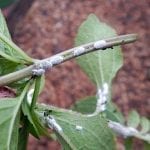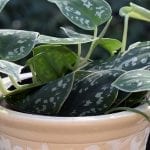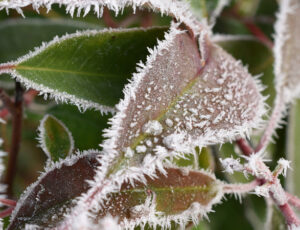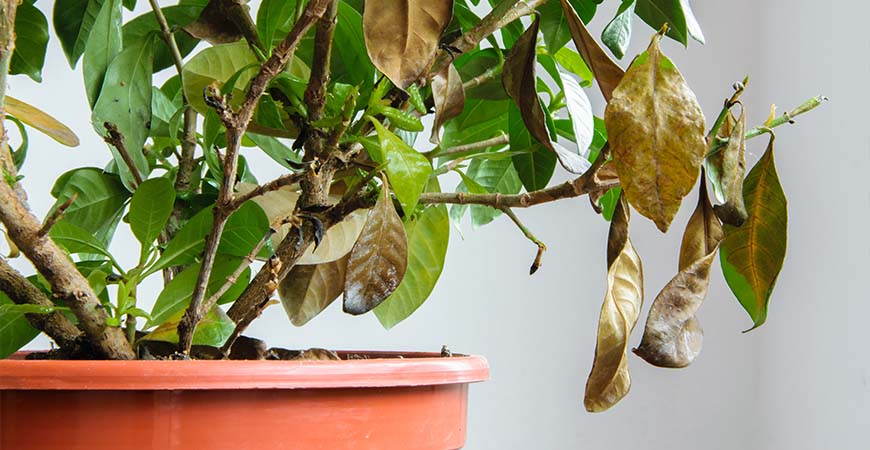
Fix Yellow Leaves on Houseplants + Cleaning Tips
Does your houseplant have yellow, brown, or pale-looking leaves? It could be due to over-watering, not enough water, disease, or other issues.
Here we cover the reasons for unhealthy leaves and solve the riddle of yellow leaves on houseplants. Plus, we include our tips for cleaning the leaves of indoor plants.
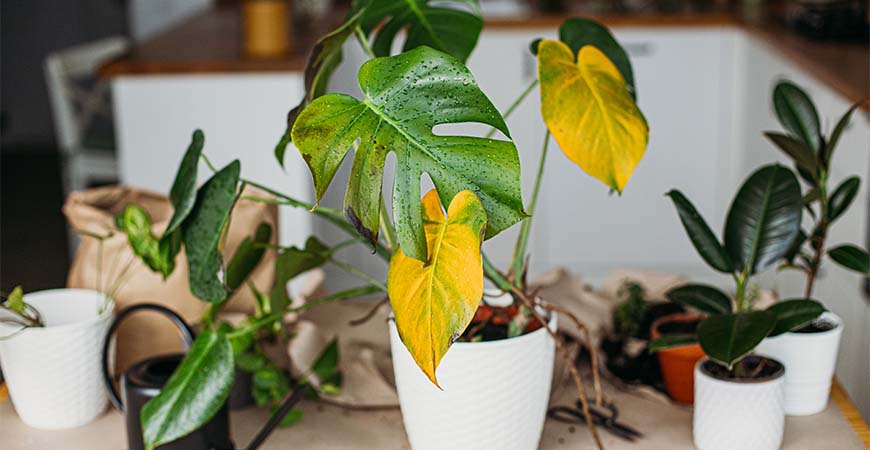
Why do my houseplant leaves turn yellow?
Yellow leaves may be due to over-watering, sudden environmental changes, low humidity, inadequate drainage, disease, too-low indoor temperatures, or the plant may be pot-bound.
Over-watering
If you suspect that your houseplant is receiving too much water, adjust your watering schedule. Search online for your plant species and change how often you water it.
Environmental Changes
If there’s been a sudden change in the weather, move the plant away from doorways or windows, especially if it’s an area that experiences cold or warm air blasts.
To prevent the leaves from yellowing, place plants away from heating and cooling vents.
Low Humidity
Boost the humidity surrounding the plant by misting it regularly or placing a small humidifier in the room.
Or set the plant on a pebble tray. You can make a pebble tray by adding small pebbles to a water-filled, shallow saucer and then set the plant on top.
Soil That Drains Too Slowly
Check that the pot drains well because the roots can suffocate if the pot isn’t draining correctly. Make sure that some airflow runs through the draining holes.
Pick deep containers because they drain more efficiently than shallow ones.
Another thing to consider is using quality potting soil with no clay in the mix. Clay will hinder proper drainage.
Add compost to the soil to loosen up the soil structure and allow water to move through the pot more easily. Check to see if the plant is root-bound. If so, replant your greenery in a larger pot.
Due To Disease
Anthracnose is a plant disease that can cause leaf tips to yellow. Eventually, the leaves will begin to turn brown and fall from the plant.
Control anthracnose by removing all affected leaves from the plant and lowering the humidity in the room. Refrain from misting the foliage.
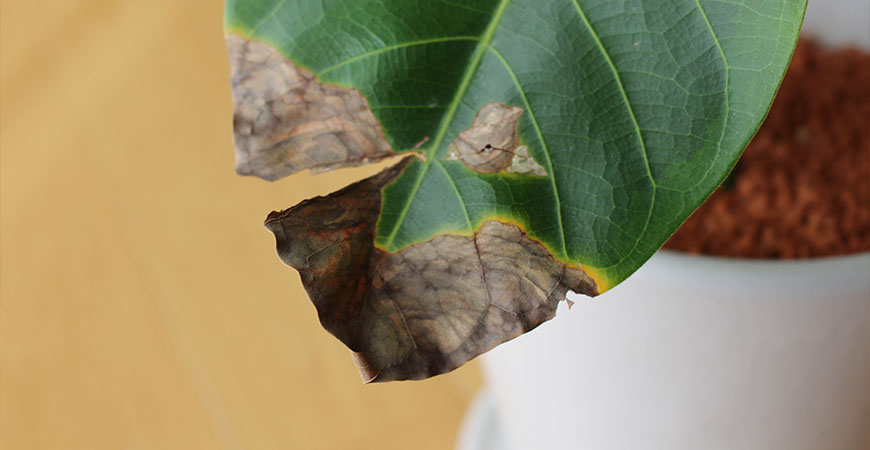
Why are my houseplant leaves turning brown?
Leaves that turn brown can be caused by dry soil, over-fertilization, or accumulated salts. Learn how to solve these soil-related plant problems below.
Dry Soil
Potting soil that drains too quickly will not provide sufficient moisture, which will cause leaf tips to turn brown. If your potting soil contains too much sand, it is probably too porous, which inhibits its ability to hold moisture.
Adding compost to the soil will boost water retention. The organic ingredients in compost act like a sponge to hold in moisture so the plant roots can reach it.
Too Much Fertilizer
Luckily, most over-fertilized plants can be saved. Here’s how:
- Look for a white or crusty residue on top of the soil. This is due to too much fertilizer, or it may be excess fertilizer left behind after moisture has evaporated.
- Simply remove the residue with a kitchen spoon gently. With this in mind, avoid disturbing the plant roots.
According to home repair expert Bob Vila, most indoor plants only need to be fertilized once a month, at most.
Bonus Solution: Leaching The Soil
Leaching the soil will help to allow the soil to absorb the water better. By doing so, it will help to remove the salt layer from the soil.
Fill a container with lukewarm, distilled water, and pour it into the plant pot. This will move water through the soil and out the bottom, flushing out excess plant food.
Repeat that process four times to ensure the fertilizer is flushed from the roots.
Wait a minimum of four weeks before you fertilize again to allow time for the plant to recover. Apply a nitrogen-free fertilizer using only 1/4 to 1/2 of the recommended amount indicated on the package.
The only thing left to do is apply water to the soil surface to flush excess salts away and out the drainage hole.
Why do my houseplants look faded or washed-out?
A houseplant with new growth that appears faded or light green may be suffering from chlorosis. One symptom of chlorosis is new leaves will be light green with darker veins. Mature plant growth will still look healthy.
A houseplant that has chlorosis lacks iron. Luckily, you can add iron to the soil by applying an iron-rich soil additive or by adding a fertilizer that is high in iron.
For best results, find a well-balanced fertilizer that contains chelated iron. Moreover, follow the package’s directions carefully, as too much iron can burn plants.
Although the faded foliage will not recover, it can be trimmed to allow new, healthy growth to take its place.
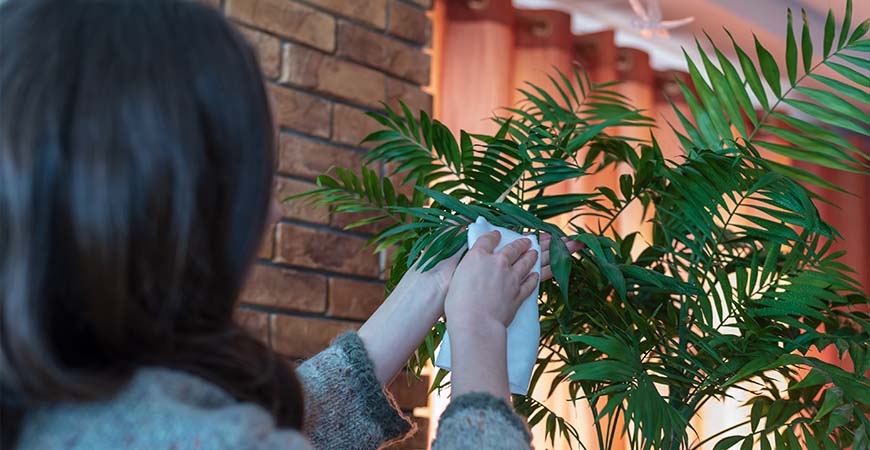
Three ways to clean houseplant leaves
1. Wipe the Leaves Clean
A dusty houseplant may not seem like a big deal, but that layer of dust will block the light. Plants use light energy to capture water, carbon dioxide, and minerals and convert them into nutrients and oxygen.
A lack of light will affect the plant’s ability to feed itself (photosynthesis). Make sure your plant stays healthy as they are less susceptible to pests and diseases.
Gently wipe the leaves with a soft, damp cloth to remove dirt and dust. Furthermore, it also makes the plant look healthy.
2. In-Sink Shower
- Begin by moving the plant to the kitchen sink to use the sink sprayer to rinse away dust.
- Set the water temperature to lukewarm before you begin.
- Wrap plastic wrap around the plant pot to prevent too much water from reaching the soil. Allow plants to air-dry before returning them to their homes.
When it comes to small plants, hold them at the base and tip to one side. Then hold it under a moderate spray to rinse the grime away.
3. Brush Lightly
Use a small, soft brush to gently remove dust from the leaves for plants with furry or velvet-like leaves such as begonia, kitten ears, or African violets.
Good brush options to consider are a soft-bristle toothbrush or mushroom brush to clean your plants.
Revive your houseplants with the tips and how-tos above, and your indoor garden will grow green again!


